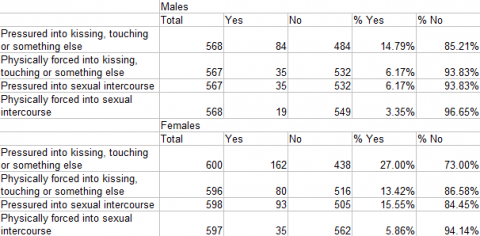Has one in three teenage girls experienced some form of sexual violence?
"One in three teenage girls in a relationship have experienced some form of sexual abuse, campaigners have revealed."
Sky News, 5 March 2012
"[The campaign] is highlighting research suggesting that a third of teenage girls and about one in six boys have experienced some form of sexual violence from a partner."
BBC News, 5 March 2012
Join 72,953 people who trust us to check the facts
Sign up to get weekly updates on politics, immigration, health and more.
Subscribe to weekly email newsletters from Full Fact for updates on politics, immigration, health and more. Our fact checks are free to read but not to produce, so you will also get occasional emails about fundraising and other ways you can help. You can unsubscribe at any time. For more information about how we use your data see our Privacy Policy.
Yesterday, several newspapers and news organisations reported that one in three teenage girls have suffered some form of sexual violence. The claim emerged as a new campaign raising awareness of sexual violence amongst teenagers was launched. The campaign seeks to highlight misconceptions about rape and the issue of sexual abuse by partners.
Analysis
The original figure is found in the results of an NSPCC survey of children across eight secondary schools. The survey was answered by 1,353 children, with the sample weighted towards older children "due to their increased opportunity of experiencing some form of relationship".
A partner is defined in the survey as being "anyone the young person had been intimate with, ranging from a serious long-term boyfriend or girlfriend, to a more casual partner or a one-off encounter".
The survey included four questions on sexual violence, asking whether respondents had been pressured or physically forced into kissing and touching or sexual intercourse. The question gave the choices of never, once, a few times, often and all the time. The table below condenses once, a few times, often and all the time into one column (yes).

The report states that "Combining all reported incidents, 31 per cent (n=185) of girls, compared to 16 per cent (n=93) of boys, experienced sexual violence from their partner" — a figure not provided in the tables.
It should be noted that because the older teenagers were deliberately more prevalent in the survey specifically because they were more likely to have had a partner.
According to the report, the analysis of sexual violence was "undertaken only on the 1,185 respondents who reported some form of a relationship", which has been confirmed by the report's authors.
The survey's findings can therefore only be properly applied to those teenage girls in a relationship, and not all teenage girls. This is a distinction that Sky succesfully made in its report, but it is not clear from the BBC's.
The report also acknowledges that three of the schools originally intended to form part of the study dropped out: two independent schools and one state school in an affluent area. This means that of the eight schools surveyed, only one was from a low deprivation area (three were from average, two high and two very high) and none were from the independent sector.
As the report itself states, the deprivation of an area is a risk factor associated with sexual violence, meaning that the under-representation of more affluent areas and independent schools could have had an impact on results.
Furthermore, the difference in participation rates between schools highlighted in the study could have accentuated or mitigated any sample bias, but as the report doesn't specify which schools had higher participation rates, we can't know how this may have affected results.
Conclusion
The 2009 survey by the NSPCC does provide some evidence that a third of teenage girls who have experienced a relationship have suffered some form of sexual violence. However, this does not mean that 31 per cent of all teenage girls have suffered sexual violence, as the BBC suggested.
The weighting of the data towards older girls, the demographic intake of the participating schools and differences in the participation rate could all have also had an affect on the results, although as the research in this field is limited (as the report notes), it is difficult to gauge to what extent.